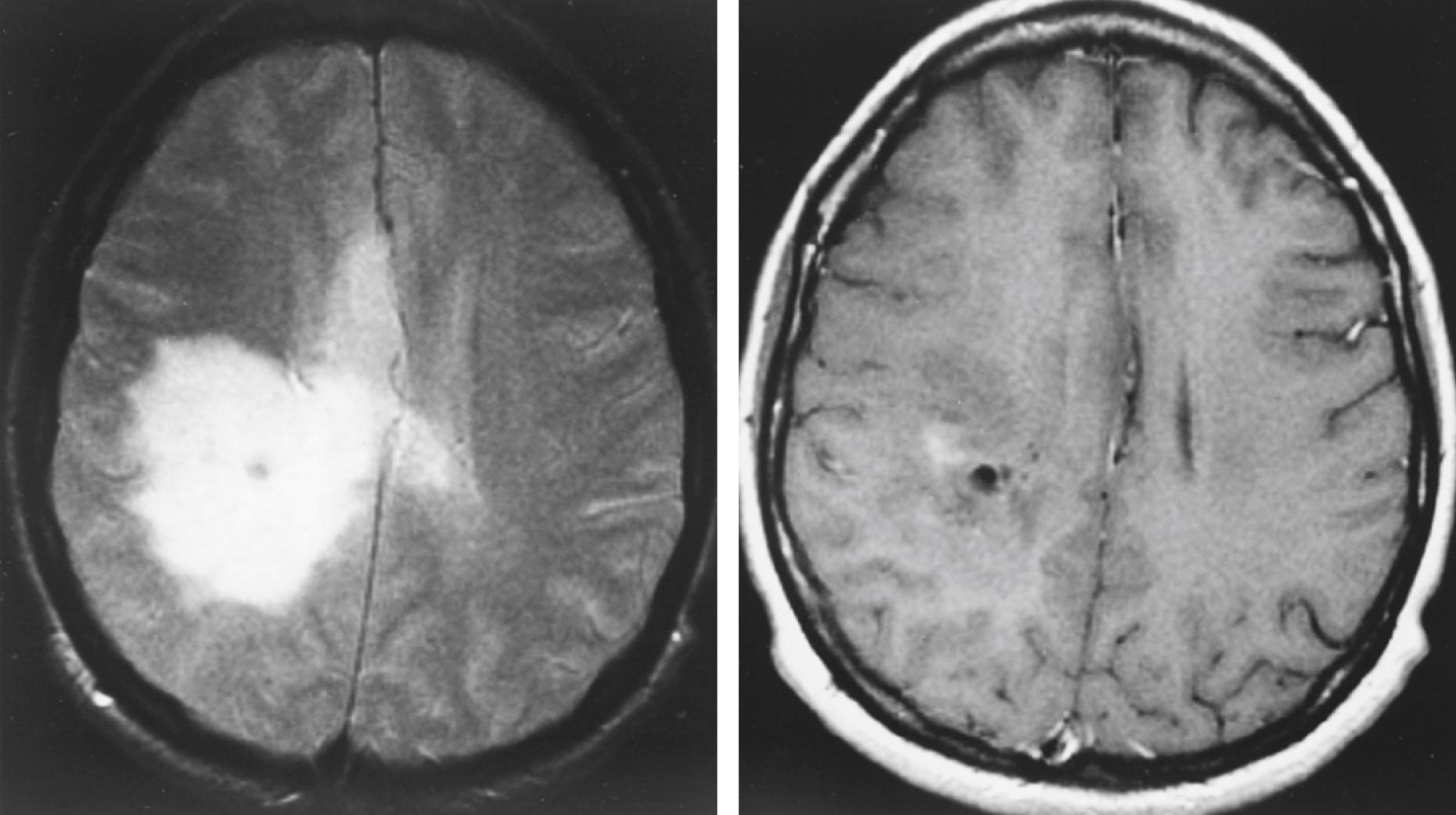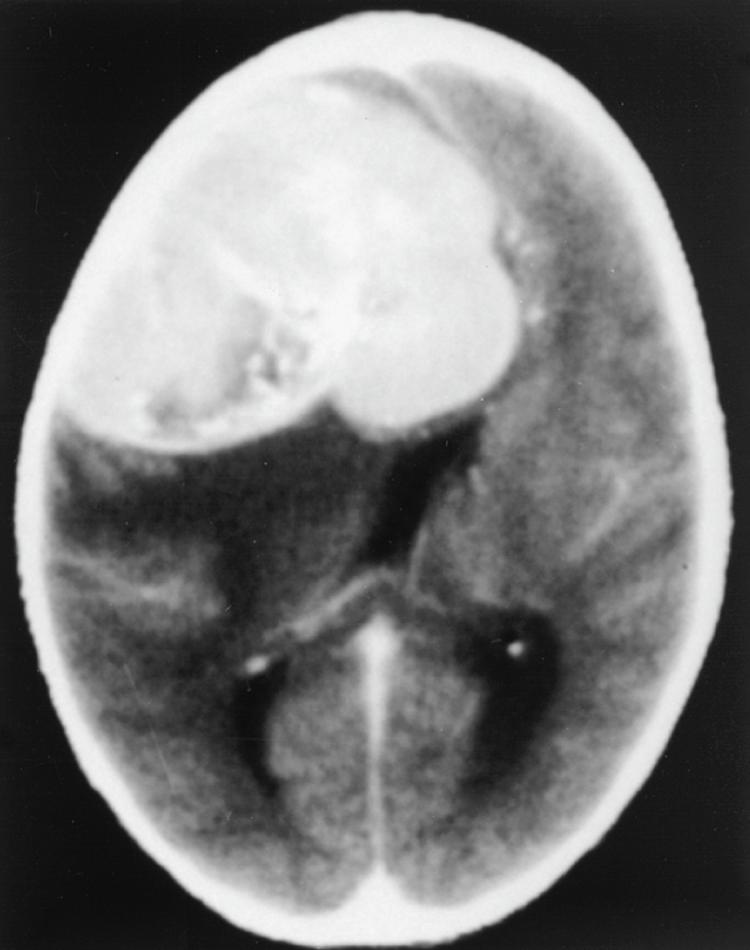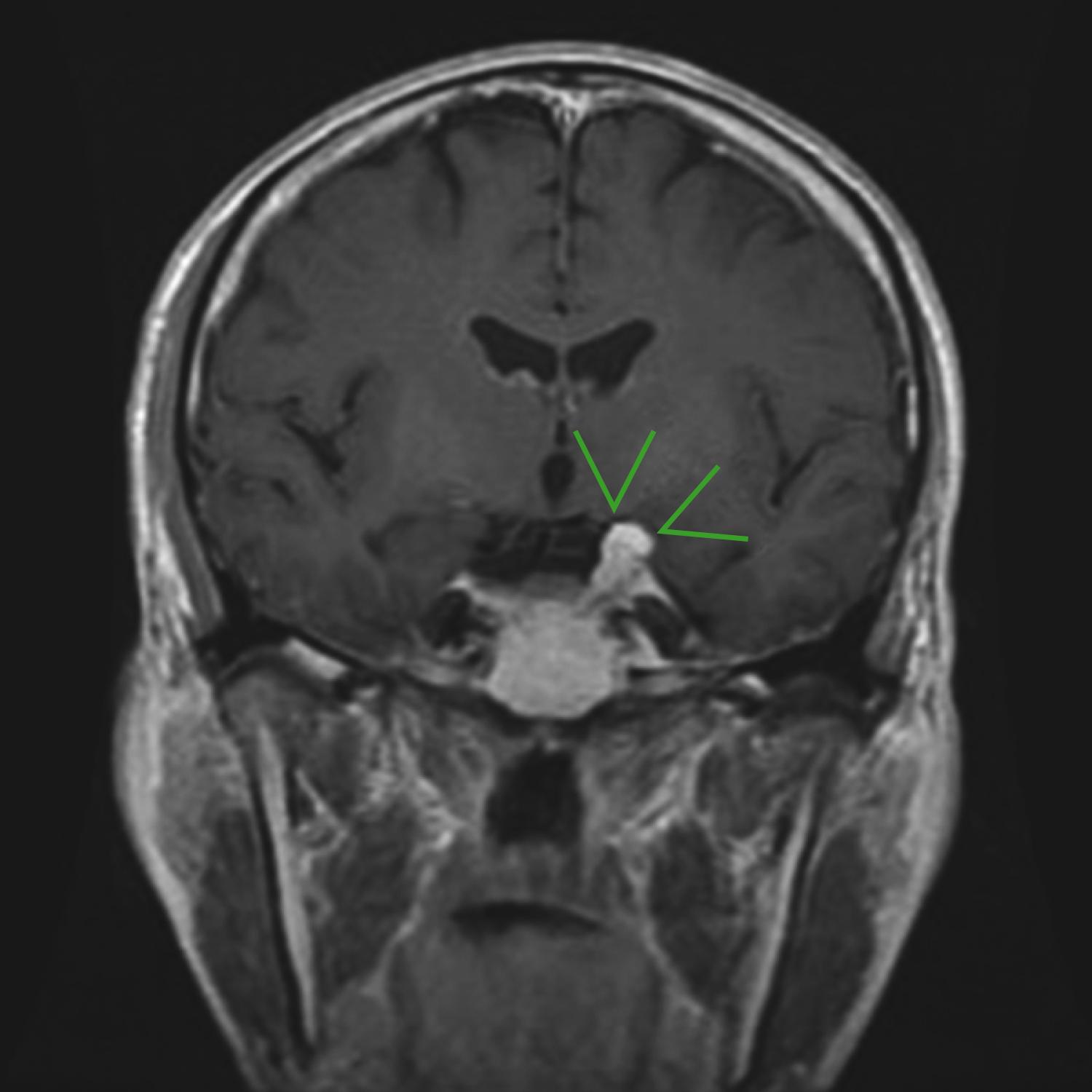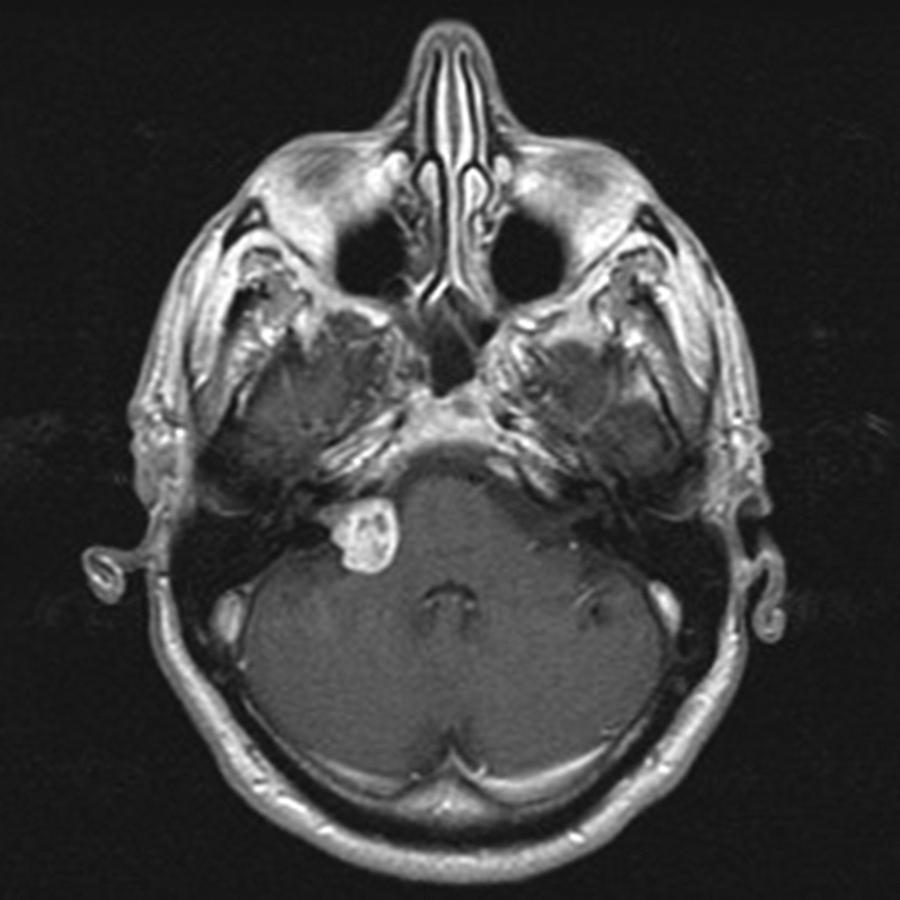Physical Address
304 North Cardinal St.
Dorchester Center, MA 02124
Central nervous system (CNS) tumors can involve the brain or the spinal cord, may be benign or malignant, and may be primary or metastatic. In the United States, about 80,000 new primary brain tumors and other nervous system tumors are diagnosed annually, and about one-third of primary CNS tumors are malignant. In contrast, intracranial metastases are five times more common than primary brain tumors.
Over 100 different types and subtypes of brain and spinal cord tumors arise from cells that make up the CNS ( Table 175-1 ). Because CNS tumors grow within the CNS and rarely if ever metastasize to other organs, conventional tumor staging approaches are not applicable, so histopathologic and molecular features are used to categorize CNS tumors. Histopathologic features that suggest more aggressive growth include cytologic atypia, increased mitotic rate, microvascular proliferation, and regional necrosis. Tumors lacking these features are still able to grow within the CNS and to cause progressive neurologic disability, and they may acquire a more malignant phenotype over time. Tumor grading includes histologic features , as well as molecular information. In difficult cases, DNA methylation patterns can help assign a tumor subtype.
| GLIOMAS, GLIONEURONAL TUMORS, AND NEURONAL TUMORS |
| Adult-type Diffuse Gliomas |
| Astrocytoma, IDH-mutant |
| Oligodendroglioma, IDH-mutant, and 1p/19q-codeleted |
| Glioblastoma, IDH-wildtype |
| Pediatric-type Diffuse Low-grade Gliomas |
| Pediatric-type Diffuse High-grade Gliomas |
| Diffuse midline glioma, H3 K27-altered |
| Diffuse hemispheric glioma, H3 G34-mutant |
| Diffuse pediatric-type high-grade glioma, H3-wildtype and IDH-wildtype |
| Infant-type hemispheric glioma |
| Circumscribed Astrocytic Gliomas |
| Pilocytic astrocytoma |
| Pleomorphic xanthoastrocytoma |
| Subependymal giant cell astrocytoma |
| Glioneuronal and Neuronal Tumors |
| Ependymal Tumors |
| CHOROID PLEXUS TUMORS |
| EMBRYONAL TUMORS |
| Medulloblastoma |
| Other CNS embryonal tumors |
| PINEAL TUMORS (INCLUDING PINEOBLASTOMA, OTHERS) |
| CRANIAL AND PARASPINAL NERVE TUMORS (INCLUDING NEUROFIBROMA, SCHWANNOMA, OTHERS) |
| MENINGIOMAS |
| MESENCHYMAL, NON-MENINGOTHELIAL TUMORS |
| MELANOCYTIC TUMORS |
| HEMATOLYMPHOID TUMORS |
| Lymphomas, including Primary CNS Lymphoma |
| Histiocytic tumors |
| GERM CELL TUMORS |
| Tumors of the sellar region |
| Craniopharyngioma |
| Pituitary adenoma/PitNET |
Extra-axial primary brain tumors arise within the intracranial cavity but are not tumors of brain tissue. Although they produce neurologic symptoms and signs by compressing the underlying brain, almost all extra-axial tumors are benign. Since the brain is rarely invaded, complete surgical excision is often feasible.
In contrast, intra-axial primary brain tumors tend to invade brain tissue diffusely, and none can be completely excised surgically. Most primary intra-axial brain tumors are gliomas, including the astrocytomas, oligodendrogliomas, and ependymomas.
A patient with a brain tumor can present with generalized and/or lateralizing symptoms and signs. Generalized symptoms, which include headache, lethargy, personality change, nausea, and vomiting, typically reflect the increased intracranial pressure that often accompanies cerebral tumors. Lateralizing symptoms, which reflect the specific location of the tumor, include hemiparesis, hemisensory deficits, aphasia, visual field impairment, and seizures ( Table 175-2 ).
| FRONTAL LOBE |
| Generalized seizures; focal motor seizures (contralateral); expressive aphasia (dominant side); behavioral changes; dementia; gait disorders; incontinence; hemiparesis (contralateral) |
| BASAL GANGLIA |
| Hemiparesis (contralateral); movement disorders (rare) |
| PARIETAL LOBE |
| Receptive aphasia (dominant side); spatial disorientation (nondominant side); cortical sensory dysfunction (contralateral); hemianopia (contralateral); agnosias |
| OCCIPITAL LOBE |
| Hemianopia (contralateral); visual disturbances (unformed) |
| TEMPORAL LOBE |
| Complex partial (psychomotor) seizures; generalized seizures; olfactory and complex visual auras; behavioral changes; visual field defect; language disorder (dominant side) |
| CORPUS CALLOSUM |
| Dementia (anterior); memory loss (posterior); asymptomatic (middle); behavioral changes |
| THALAMUS |
| Sensory loss (contralateral); language disorder (dominant side); behavioral changes |
| MIDBRAIN/PINEAL |
| Paresis of vertical eye; pupillary abnormalities; precocious puberty (boys) |
| SELLA/OPTIC NERVE/PITUITARY |
| Endocrinopathy; bitemporal hemianopia; monocular visual defects; ophthalmoplegia (cavernous sinus) |
| PONS/MEDULLA |
| Cranial nerve dysfunction; ataxia; nystagmus; spasticity; weakness; sensory loss |
| CEREBELLOPONTINE ANGLE |
| Deafness (ipsilateral); loss of facial sensation (ipsilateral); facial weakness (ipsilateral); ataxia |
| CEREBELLUM |
| Ataxia (ipsilateral or gait); nystagmus |
Symptoms of brain tumors can be produced by tumor that directly invades the brain parenchyma, when tumor and edema compress brain tissue, when obstruction to cerebrospinal fluid (CSF) is directly caused by the tumor or by a shift of brain tissue, and when herniation occurs. Invasion and compression typically produce lateralizing symptoms, whereas obstruction of the flow of cerebrospinal fluid and herniation typically produce generalized symptoms but can also cause false localizing signs, such as an abducens nerve palsy as a result of diffuse increased intracranial pressure.
Headache ( Chapter 367 ) is a presenting symptom of approximately 35% of brain tumors. It is more common in younger than in older patients and more common in patients who have rapidly growing tumors than in patients whose tumors have evolved slowly. Local growth of the tumor may cause mental and cognitive abnormalities (e.g., aphasia, alexia, agnosia) or general impairment (e.g., lethargy, confusion, word finding difficulty, apathy).
Most patients have symptoms that progress during a week to a few months. A sudden intensification of symptoms may precipitate the patient’s initial visit to the physician, but a careful history usually reveals symptoms that predated the acute deterioration and slowly worsened over time. Two exceptions are the new appearance of a seizure in a previously asymptomatic individual ( Chapter 372 ) and sudden hemorrhage into a tumor.
Seizures ( Chapter 372 ) affect approximately one-third of patients with brain tumors, and they are especially common as the presenting and only symptom of a low-grade tumor. The seizures, which are focal because they originate at the site of the tumor, may remain restricted (e.g., focal motor seizures), or they may generalize secondarily to produce loss of consciousness, sometimes so quickly that the focal signature is missed by the patient or even an observant witness.
A careful history and physical examination ( Chapter 366 ) should assess cognitive function ( Chapter 361 ) and search for any lateralizing signs. Routine hematologic and blood chemistry tests should be obtained to exclude a metabolic cause of mental status changes ( Chapter 361 ). However, urgent brain imaging is required when the diagnosis of a brain tumor is suspected.
Magnetic resonance imaging (MRI) should be performed both without and with intravenous administration of gadolinium, preferably using a standardized brain tumor imaging protocol. A well-performed MRI identifies any intracranial tumor, and a normal MRI effectively excludes a neoplasm.
The MRI of some extra-axial tumors (e.g., acoustic neuromas, meningiomas) is so characteristic that histologic confirmation is not required. A non–contrast-enhancing infiltrative lesion that is visible primarily on T2-weighted or fluid-attenuated inversion recovery images is most consistent with a low-grade glioma ( Fig. 175-1 ). A contrast-enhancing lesion with an area of central necrosis and surrounding edema is most likely to be a glioblastoma or possibly a brain metastasis.

MRI is far superior to computed tomography (CT) for the diagnosis of brain tumors and should be obtained in all patients with a suspected intracranial tumor. A CT scan, even with the administration of contrast material, may miss low-grade tumors and tumors in the posterior fossa, so a CT scan should be obtained only in patients who cannot undergo MRI.
In less clear cases, functional imaging techniques can be helpful to distinguish a brain tumor from other CNS lesions. Examples include cerebral blood volume (perfusion MRI), loss of tumor cellularity (diffusion-weighted MRI), the flow of contrast agent across a damaged blood-brain barrier (dynamic contrast-enhanced MRI), or the abundance of certain metabolites (MR spectroscopy). Malignant tumors, for example, are associated with an increased choline : N -acetylaspartate ratio and may contain areas with elevated levels of lactate and lipid. Functional MRI, which measures cerebral blood flow when areas of cortex are activated, may guide a safer and more complete surgical resection by localizing critical neurologic functions and their relationship to the tumor. Angiography no longer has a diagnostic role, but angiographic embolization is occasionally useful preoperatively to reduce the vascularity of some meningiomas, thereby making a complete resection safer.
Biopsy is typically part of a surgical procedure to remove the tumor to the greatest degree that is safe. However, most lesions that cannot be resected are still amenable to biopsy for diagnostic purposes. Stereotactic biopsy can reach lesions in almost any area of the brain with minimal morbidity. The risks of stereotactic biopsy include an inadequate tissue sample to make a diagnosis, a tissue sample that does not accurately reflect the most malignant grade of the tumor, and a procedure-related complication. Hemorrhage that causes neurologic impairment occurs in only 2% of stereotactic biopsies, typically in patients with glioblastomas. Unfortunately, some tumors, such as brain stem gliomas, are in such critical locations that biopsy should not be attempted.
Electroencephalography (EEG) can be useful when a patient with a brain tumor has prolonged or unexplained confusion or stupor and for whom nonconvulsive status epilepticus is a consideration. Intraoperative monitoring is used frequently to help guide resection of epileptogenic cortex adjacent to or within the brain tumor tissue or to perform intraoperative mapping of critical functions to facilitate a safe, complete resection.
Cerebrospinal fluid analysis has a limited role in the diagnosis of most intracranial neoplasms. In primary CNS lymphoma ( Chapter 171 ), however, the diagnosis may be established on cerebrospinal fluid cytologic examination in about 15% of patients. The sensitivity of cerebrospinal fluid cytology in the diagnosis of CNS lymphoma increases when it is combined with flow cytometry and is further enhanced by immunophenotypic and molecular genetic analyses of the cerebrospinal fluid. Rarely, a lumbar puncture is required to exclude inflammatory conditions or other processes that may be confused with a primary brain tumor. Lumbar puncture must be avoided in patients with cerebellar tumors because the release of pressure through the spinal needle may result in herniation of the cerebellar tonsils through the foramen magnum. The ability to detect tumor-derived DNA and circulating tumor cells in cerebrospinal fluid from some patients with CNS tumors may be helpful to monitor the tumor’s evolution and response to therapy without the need for neurosurgical procedures.
Patients who present with symptoms of raised intracranial pressure or the new onset of central neurologic symptoms, such as hemiparesis or seizure, must be evaluated urgently. Prompt neuroimaging discloses a mass, and the radiographic features narrow the differential diagnosis ( Table 175-3 ). Extra-axial tumors, such as a meningioma or acoustic neuroma, can be confused with a dural metastasis. Low-grade intra-axial tumors, which are nonenhancing on MRI, have been confused with infections such as herpes encephalitis ( Chapter 383 ) when they involve the temporal lobe. Contrast-enhancing intra-axial tumors can be confused with a stroke ( Chapter 376 ), brain abscess ( Chapter 382 ), or focal plaque of demyelination ( Chapter 380 ). Subacute infarction can show brisk contrast enhancement, usually in a gyral pattern, unlike brain tumors in which enhancement is primarily in the white matter; however, the two are occasionally indistinguishable radiographically. Brain abscesses ( Fig. 382-1 ) typically have a thinner enhancing wall than a malignant tumor and have restricted diffusion. Despite careful evaluation, patients thought to have a malignant glioma occasionally are found at surgery to have a brain abscess. A single large plaque of demyelination can also be confused radiographically with a brain tumor and sometimes the diagnosis can be established only by biopsy.
| INFECTION |
| Brain abscess ( Chapter 382 ) |
| Bacterial |
| Fungal |
| Parasitic (e.g., cysticercosis; Chapter 325 ) |
| Herpes encephalitis ( Chapter 383 ) |
| VASCULAR DISEASE |
| Stroke ( Chapter 376 ) |
| Intracranial hemorrhage ( Chapter 377 ) |
| INFLAMMATORY CONDITIONS |
| Granuloma (sarcoid; Chapter 83 ) |
| Multiple sclerosis ( Chapter 380 ): tumefactive single large lesion |
| VASCULAR MALFORMATIONS |
| Cavernous angiomas ( Chapter 377 ) |
| Venous angiomas ( Chapter 377 ) |
| CONGENITAL ABNORMALITIES |
| Cortical dysplasia ( Chapter 385 ) |
| Heterotopia ( Chapter 385 ) |
When MRI suggests a primary brain tumor, an extensive systemic search for a possible source of metastasis is rarely required. Brain metastases are more common than primary brain tumors, but most occur in patients with known cancer, typically with active systemic disease. If an obvious systemic cancer is not revealed by a thorough physical examination, chest radiograph, routine blood tests, and urinalysis, the patient should proceed to craniotomy. Even if a brain metastasis is found at surgery, resection of a single brain metastasis is the appropriate treatment, and the pathologic examination of the lesion guides the subsequent search for the primary tumor.
The treatment for all brain tumors can be divided into two main categories: symptomatic therapy and tumor-directed therapy ( Table 175-4 ). Symptomatic treatment addresses cerebral edema, thromboembolic disease, and seizures, all of which can contribute substantially to clinical symptoms caused by the tumor.
| SYMPTOMATIC TREATMENT |
| Glucocorticoids |
| Antiepileptics |
| Venous thromboembolism prophylaxis and treatment |
| TUMOR-DIRECTED THERAPY |
| Surgery |
| Radiation therapy |
| Chemotherapy or other systemic therapy |
Corticosteroids (typically dexamethasone starting at 8 to 12 mg/day) decrease the vasogenic edema that often surrounds primary and metastatic brain tumors. Clinical improvement may begin within minutes, and patients frequently improve dramatically within 24 to 48 hours. This dose is then adjusted to find the lowest dose that alleviates neurologic symptoms. Once- or twice-daily dosing is preferred for maintenance therapy over more frequent dosing. After definitive treatment is instituted, many patients can be tapered off their corticosteroid completely. Chronic high-dose corticosteroid therapy is associated with substantial side effects ( Chapter 28 ) and should be avoided if possible. Common side effects include insomnia, steroid myopathy, gastrointestinal complications, and opportunistic infections. Patients who will be taking corticosteroids for 6 weeks or longer should receive prophylaxis against Pneumocystis jirovecii ( Chapter 313 ). Antibodies that block the effects of vascular endothelial growth factor (VEGF), such as bevacizumab, can be very effective in the management of symptomatic cerebral edema and can reduce corticosteroid requirements.
Venous thromboembolism affects about 25% of patients who have brain tumors. All patients undergoing neurosurgery should have pneumatic compression boots in the postoperative period to reduce the incidence of venous thromboembolism. Prophylactic anticoagulants ( Chapter 68 ) also have been used successfully in the immediate postoperative period without increasing postoperative hemorrhage. Appropriately regulated anticoagulation ( Chapter 70 ) is the optimal therapy for deep vein thrombosis and is not associated with an increased risk for intracerebral hemorrhage. Inferior vena cava filters can be used for patients who have deep vein thrombi or pulmonary emboli and who cannot be fully anticoagulated.
Anticonvulsant medications ( Chapter 372 ) are administered to any patient who has had a seizure, but prophylactic anticonvulsants should not be prescribed for patients who have never had a seizure, except in the immediate perioperative period. When used, the dose of antiepileptic agents generally should be tapered beginning 2 to 3 weeks after craniotomy.
Complete excision is the goal for a primary brain tumor. Surgical excision can often be accomplished for primary extra-axial tumors, such as meningiomas and acoustic neuromas, unless their intracranial location makes resection impossible. Tumors of the skull base are particularly difficult to remove, and partial resection for decompression is often performed to preserve neurologic function. The safe boundaries for resecting cortical lesions while preserving function often can be elucidated by preoperative functional MRI and intraoperative cortical mapping. However, lesions involving critical structures, such as the brain stem or thalamus, cannot be excised safely.
Complete excision can cure an extra-axial primary brain tumor and is associated with prolonged survival and better neurologic outcome, even in patients with primary intra-axial tumors. In patients with malignant and lower grade gliomas, gross total excision, as measured by postoperative neuroimaging, is associated with prolonged survival. However, most low-grade gliomas are not amenable to gross total excision, and only partial excision is usually feasible. In patients with high-grade gliomas, macroscopic tumor frequently can be removed completely, but microscopic disease that infiltrates surrounding brain tissue always remains.
A course of external beam radiation therapy is delivered in small daily fractions to a total cumulative dose usually between 45 and 60 Gy. Dividing the treatment into small daily fractions permits sublethal repair in normal tissues and markedly reduces the neurologic toxicity that is associated with cerebral irradiation. External beam radiation, which is the most effective nonsurgical treatment of brain tumors, doubles median survival time of patients with malignant primary brain tumors or metastatic lesions. Radiation therapy can also be useful for recurrent meningiomas and acoustic neuromas. However, it only rarely cures any of these lesions, and most patients develop recurrent disease despite maximal radiation therapy.
Stereotactic radiosurgery delivers high fractions of focused radiation therapy that spare normal surrounding tissue. The technique is generally limited to tumors that are 3 cm in diameter or smaller and is less useful for malignant gliomas because of their infiltrative nature.
The neurologic complications of radiation therapy, which are usually observed months to years after completion of treatment, include radionecrosis, dementia, and leukoencephalopathy. The incidence is reported as less than 5%, and most patients die of their brain tumor before the delayed consequences of treatment can be observed. However, in long-term survivors (e.g., patients with lower grade glioma or children with medulloblastoma), the late consequences of radiation therapy are important. Dementia accompanying radiation-induced leukoencephalopathy can progress and result in severe neurologic impairment. Radionecrosis can mimic recurrent tumor with a large contrast-enhancing lesion on MRI. Corticosteroids under expert supervision can reduce the edema and sometimes are sufficient to treat small areas of radionecrosis. However, if the lesion is sufficiently large, resection may be required to decompress the mass and reduce the corticosteroid requirement. Laser interstitial thermal therapy is also a possible therapeutic approach for intractable radionecrosis.
Systemic medical therapies vary depending on the type and grade of the tumor. Currently, all such regimens are palliative rather than curative, except for some patients who have CNS lymphomas.
Meningiomas are the most common primary CNS tumors and are usually benign. Between 10 and 15% of meningiomas are atypical or malignant variants with a more aggressive course. Meningiomas are more common in women and may be multiple in about 10% of patients with sporadic meningioma.
Exposure to ionizing radiation elevates the risk for meningioma. Meningiomas are occasionally part of a familial syndrome and occur with increased frequency in patients with neurofibromatosis type 2 (NF2; Chapter 385 ). Inactivation of NF2 is seen in approximately 50% of sporadic tumors. Other genes are also mutated frequently in meningioma (e.g., SMO , AKT1 , KLF4 , TRAF7 ), but the role of these alterations in the development or growth of meningioma remains to be defined.
Meningiomas grow slowly and produce symptoms that are insidious in onset and typically slowly progressive. Frequently, meningiomas are completely asymptomatic and are identified on neuroimaging done for another purpose, such as head trauma.
Tumors can reach a considerable size ( Fig. 175-2 ), but they grow so slowly that the brain accommodates to the progressive compression. Meningiomas typically occur in specific locations: over the convexity, along the falx and parasagittal area, in the olfactory groove, at the base of the skull near the sphenoid bone, in the cavernous sinus ( Fig. 175-3 ), in the cerebellopontine angle, and in the foramen magnum. Cortical and parasagittal tumors typically are manifested with seizures or progressive hemiparesis. Tumors in the anterior cranial fossa can cause slowly progressive cognitive and personality changes. Meningiomas at the base of the skull are manifested with cranial neuropathies and gait difficulties when the brain stem is compressed.


On MRI, meningiomas have a characteristic appearance consisting of a diffusely enhancing, dural-based lesion that is associated with a thin enhancing dural tail that extends from the tumor. The radiographic features are often so characteristic that biopsy is not required and surgery is performed for therapeutic purposes only. The radiographic differential diagnosis includes the less common hemangiopericytoma and dural metastasis. Most meningiomas are not accompanied by significant edema, but marked edema is seen with high-grade malignant lesions or the secretory variant.
If small meningiomas are discovered in the absence of clinical symptoms or the symptoms are minor, lesions may be monitored with serial images because growth can be so slow. If treatment is indicated, complete resection is often curative, but even completely resected benign tumors may recur in as many as 20% of cases, so radiologic follow-up is essential. Tumors at the base of the skull often cannot be resected completely and tend to recur despite successive attempts at surgical resection. Stereotactic radiosurgery may be an alternative to surgery if the lesion is small or if patients have progressive or residual tumor. External beam radiation therapy may slow progression of recurrent lesions and is essential for the treatment of malignant meningiomas.
DNA methylation profiling and determination of CDKN2A/B gene copy loss can provide prognostic information. No effective systemic therapy has been identified for recurrent meningioma.
Vestibular schwannomas, also called acoustic neuromas ( Chapter 396 ), are benign tumors that arise from the eighth cranial nerve. Vestibular schwannomas are twice as common in women as in men, with a peak incidence between ages 40 and 60 years. Sporadic vestibular schwannomas are unilateral, whereas bilateral vestibular schwannomas are pathognomonic of neurofibromatosis type 2 ( Chapter 385 ).
Vestibular schwannomas usually arise from the vestibular portion of the nerve and typically are manifest by unilateral hearing loss, sometimes preceded or accompanied by tinnitus and a sensation of dizziness or unsteadiness but not true vertigo ( Chapter 396 ). The slow, progressive enlargement of the tumor produces ipsilateral facial numbness or weakness by compressing the fifth or seventh cranial nerve, respectively. Tumors originate within the internal auditory meatus but grow out of the acoustic canal and into the cerebellopontine angle, where they can compress the brain stem and cause ataxia and ipsilateral cerebellar signs. Cranial MRI with gadolinium delineates even small acoustic neuromas with ease ( Fig. 175-4 ).

Treatment is often surgical, but stereotactic radiosurgery is an effective alternative, especially for lesions smaller than 3 cm. Tumors should be treated when they are small to preserve facial nerve function and hearing.
Pituitary adenomas are discussed in Chapter 205 .
Become a Clinical Tree membership for Full access and enjoy Unlimited articles
If you are a member. Log in here